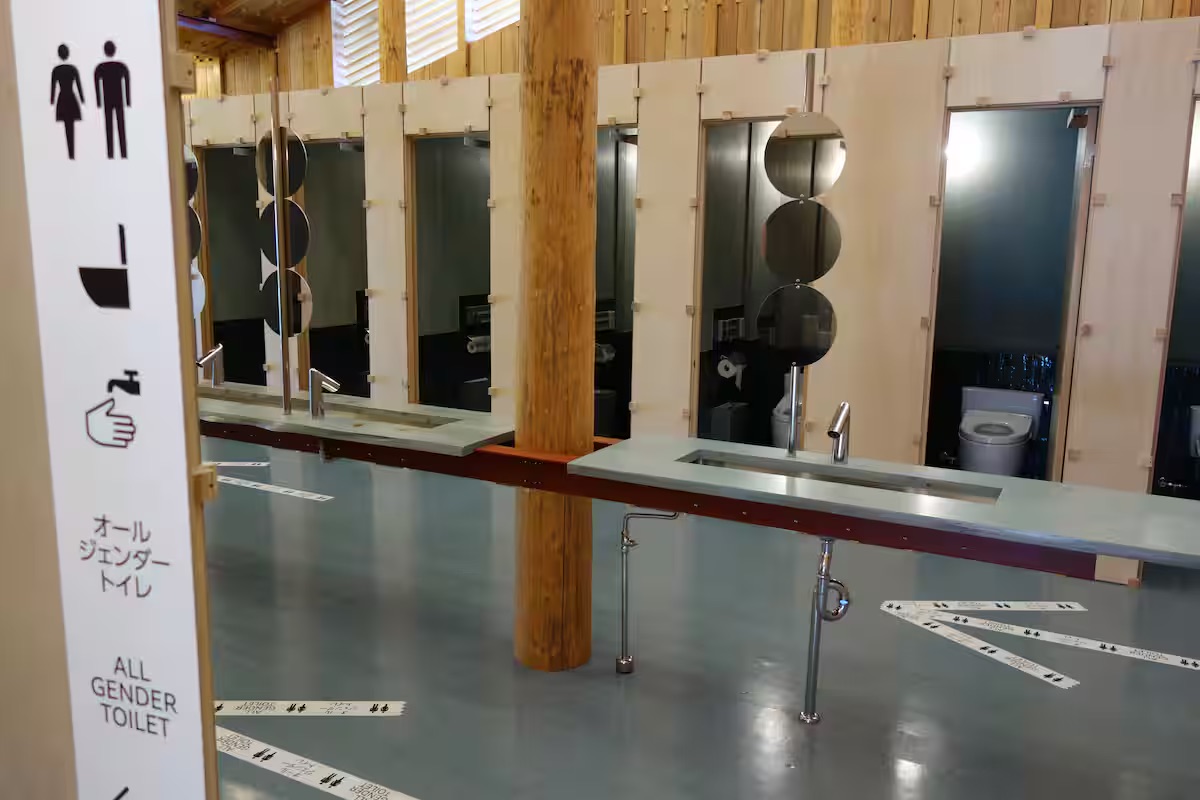Expo 2025's Gender-Neutral Toilets Spark Heated Debate
2025年の大阪・関西万博で「オールジェンダートイレ」が導入され、話題になっています。性別に関係なく使える設計は、多様性を意識した新しい試みですが、安全面やプライバシーの面から不安の声も上がっているようです。公共の場のトイレについて、どんな配慮がいちばん大切だと思いますか?レッスンで話してみましょう。

1.Article
Directions: Read the following article aloud.
※本ページは出典ニュース記事を要約した英文です。
According to the Expo Association's official website, 112 gender-neutral toilets have been installed across 18 of the 46 restrooms throughout the venue.
During a press preview on April 9, it was confirmed that 33 of these toilets were located in a large restroom near the "Forest of Tranquility," a central area within the site.
The layout features gender-neutral toilet stalls on both sides of a shared area with communal sinks and mirrors. Male urinals are located further inside, requiring users to walk through the shared space to reach them.
Expo officials explained that one purpose of the gender-neutral toilets is to reduce long lines at women's restrooms. They noted, "For women who prefer not to share facilities with men, there are also dedicated women's toilets available."
Three women-only stalls are available in the restroom in the shared restroom area as well, each equipped with a sink.
However, there are no men-only stalls in the same area. Signage directs male users seeking separate facilities to the nearest gender-separated restroom.
A previous attempt to introduce gender-neutral toilets was at the Tokyu Kabukicho Tower, which opened in April 2023. That facility featured eight shared stalls, two women-only stalls, and two men-only stalls, along with shared sinks. Following backlash, the design was revised to fully separate the restrooms by gender about four months later.
Another toilet-related controversy at Expo 2025 involves the design of the children-only restrooms. In these restrooms, child-sized urinals and toilets are arranged without gender separation or partitions, prompting debate online.
Critics on social media compared the design to "evacuation shelters during disasters," while others pointed out that similar layouts are common in nursery schools.
According to the Expo Association's website, 12 of the 46 restrooms at the venue feature child-sized toilets in addition to standard facilities.
However, the two children-only restrooms at the "Lost Child Center and Baby Center" near the East and West gates have raised concerns. These have three child-sized toilets and two urinals lined up, separated only by low plastic partitions. Such designs are extremely rare in Japan.
Opinions online are divided. Some defended the design, noting, "As someone in architectural design, this is the norm for toilets used by 1- to 3-year-olds."
Others expressed concern: "This setup ignores the psychological needs of modern children," and "In daycare, children are surrounded by familiar adults — but public spaces are full of strangers. This isn't appropriate.“
The issue was raised in a cabinet committee session on April 15 by Noriko Ishigaki, an upper house member from the Constitutional Democratic Party. She criticized the design, saying, "Doesn't this show a lack of consideration for children's privacy? Even with a guardian present, kids are still exposed to adult strangers."
A Ministry of Economy, Trade and Industry official responded that the facilities are intended for children aged 0–2 and are to be used only when accompanied by guardians. The restrooms are monitored by staff to prevent unauthorized access and are designed to be used by one family group at a time. "Other groupings are only allowed with mutual consent," the official added.
Ishigaki pushed back, saying, "Sure, you might have a family with triplets or twins close in age, but still [...] The explanation that the toilets are meant for use by a single group, and that others can join with consent, just doesn't hold up. If it's a design flaw, then the simple solution is to fix it by adding partitions."
本教材は、一般社団法人ジャパンフォワード推進機構、株式会社産経デジタルより許諾を得て、産経ヒューマンラーニング株式会社が編集しています。
テキストの無断転載・無断使用を固く禁じます 。

